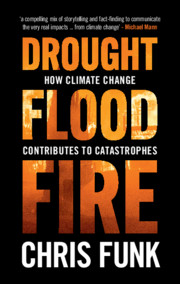Book contents
- Drought, Flood, Fire
- Drought, Flood, Fire
- Copyright page
- Contents
- Acknowledgments
- 1 Climate Extremes, Climate Attribution, Extreme Event Attribution
- 2 Welcome to an Awesome Planet
- 3 The Earth Is a Negentropic System, or “the Bright Side of Empty”
- 4 Do-It-Yourself Climate Change Science
- 5 Temperature Extremes – Impacts and Attribution
- 6 Precipitation Extremes
- 7 Hurricanes, Cyclones, and Typhoons
- 8 Conceptual Models of Climate Change and Prediction, and How They Relate to Floods and Fires
- 9 Climate Change Made the 2015–2016 El Niño More Extreme
- 10 Bigger La Niñas and the East African Climate Paradox
- 11 Fire and Drought in the Western United States
- 12 Fire and Australia’s Black Summer
- 13 Driving toward +4°C on a Dixie® Cup Planet
- 14 We Can Afford to Wear a White Hat
- Appendix A Few Resources for Further Reading and Research
- Index
13 - Driving toward +4°C on a Dixie® Cup Planet
Published online by Cambridge University Press: 01 June 2021
- Drought, Flood, Fire
- Drought, Flood, Fire
- Copyright page
- Contents
- Acknowledgments
- 1 Climate Extremes, Climate Attribution, Extreme Event Attribution
- 2 Welcome to an Awesome Planet
- 3 The Earth Is a Negentropic System, or “the Bright Side of Empty”
- 4 Do-It-Yourself Climate Change Science
- 5 Temperature Extremes – Impacts and Attribution
- 6 Precipitation Extremes
- 7 Hurricanes, Cyclones, and Typhoons
- 8 Conceptual Models of Climate Change and Prediction, and How They Relate to Floods and Fires
- 9 Climate Change Made the 2015–2016 El Niño More Extreme
- 10 Bigger La Niñas and the East African Climate Paradox
- 11 Fire and Drought in the Western United States
- 12 Fire and Australia’s Black Summer
- 13 Driving toward +4°C on a Dixie® Cup Planet
- 14 We Can Afford to Wear a White Hat
- Appendix A Few Resources for Further Reading and Research
- Index
Summary
To explore our collective future, scientists develop plausible emission, pollution, and land use scenarios. Some of these scenarios describe rapid economic and population growth, and concomitant increases in fossil fuel emissions. Other scenarios describe a rapid transition to clean energy and increased efficiency. Data from the 2019 Global Carbon Project carbon budget indicate that 2019 emissions were very close to scientists’ most dangerous emissions pathway. Like a marble careening across the top of an inverted paper Dixie cup, these rapid emissions could lead to runaway global warming, risking a planetary plummet if temperature increases shrink ice caps, reduce the ocean and land’s ability to sequester carbon dioxide, and/or increase fire emissions. Examining national emission statistics, we see that the United States is by far the greatest per capita emitter. There is some good news, however. Global energy use intensity, the amount of carbon emissions per unit of gross domestic product, is increasing rapidly. We can make more goods and services using relatively less emissions. Solar energy is rapidly becoming more affordable. But emissions have already contributed to an exponential increase in disasters costing some $2.2 trillion over the past two decades.
Keywords
- Type
- Chapter
- Information
- Drought, Flood, FireHow Climate Change Contributes to Catastrophes, pp. 268 - 286Publisher: Cambridge University PressPrint publication year: 2021

